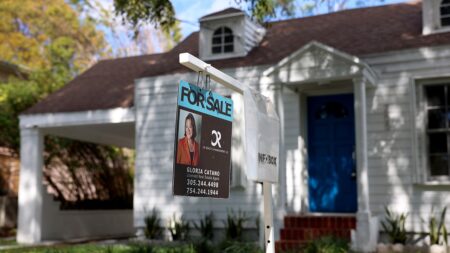Consumer debt keeps climbing, and the strain is showing in the mounting number of car-loan and credit-card delinquencies, according to new data from the Federal Reserve Bank of New York.
While many U.S. consumers’ finances are holding up, Tuesday’s data shows that some troubled pockets are forming, with lower-income households and younger consumers falling behind faster, researchers say.
Total household debt, including mortgages, car loans, credit cards and student loans, climbed to $17.5 trillion in the fourth quarter, according to the New York Fed’s quarterly report on household debt.
As inflation rates cool, New York Fed researchers note that is a roughly 1% quarterly rate of growth, which is on par with the previous quarter.
But researchers are particularly watching credit-card balances and car loans, for which transitions into delinquency keep climbing above prepandemic levels. “This signals increased financial stress, especially among younger and lower-income households,” Wilbert van der Klaauw, an economic research adviser at the New York Fed, said in a statement.
And while delinquencies are rising for all demographics, the researchers said credit-card delinquencies are particularly pronounced among millennials — the generation born between 1980 and 1994 — and among the lowest quartile of households by income, whose debts and basic expenses eat up a larger share of household funds.
Those debts are also pressing on households as student-loan payments resume. This quarter, student-loan balances were essentially flat, gaining $2 billion to stand at $1.6 trillion by the New York Fed’s count.
Consumers tacked on an additional $50 billion in credit-card debt during the fourth quarter, which includes the holiday shopping season. Americans’ card balances now stand at $1.13 trillion.
During the fourth quarter, 8.5% of credit-card debt became 30 or more days past due and 6.3% flowed into serious delinquency, meaning it was at least 90 days past due.
The second quarter of 2011 was the last time serious delinquency rates were higher, New York Fed data shows.
The percentages are on an annualized basis.
Car loans
Meanwhile, car-loan balances added another $12 billion to climb to $1.6 trillion in the fourth quarter.
For car loans, 7.6% of debt became 30 days late and 2.6% became 90 days late. The second quarter of 2010 was the last time the share of car-loan debt was higher for delinquencies that were at least 90 days behind.
The car-loan delinquencies underscore the high cost of cars these days, particularly for buyers with lower credit scores.
Car buyers with low credit scores who need financing face steep borrowing costs, with interest rates on new-car loans for subprime borrowers ranging from 17% to 22% last year, according to Fitch Ratings.
During the fourth quarter, nearly 16% of people who needed financing to buy a new car were going to spend at least $1,000 monthly, not including car-insurance costs.
The average transaction price as of December was $48,759, according to Cox Automotive.
Like many aspects of the economy right now, when it comes to debt, mixed signals point toward strengths as well as weaknesses. Although delinquencies are increasing, the New York Fed numbers show that more household debt is current compared with just before the start of the pandemic in early 2020.
Read the full article here












